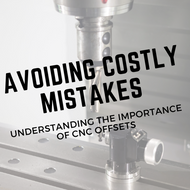Avoiding Costly Mistakes: Understanding the Importance of CNC Offsets
Published by Kortney on Jun 21st 2023
Precision is everything in the manufacturing process, and even the slightest error can cost a company thousands of dollars. With the advancement of technology, computer numerical control (CNC) machines have become a staple in the manufacturing industry, providing high levels of accuracy and efficiency. However, to achieve precision, you need to understand the importance of CNC offsets. In this article, we will delve into the world of CNC offsets, review real-world examples of errors caused by their misuse and explore how to use them effectively. By the end of this article, you'll have a better understanding of CNC offsets, their importance, and how they can prevent costly mistakes in your machining operations.
Defining CNC Offsets
To understand the importance of CNC offsets, you first need to understand what they are. In simple terms, CNC offsets are values that compensate for tool wear, measurement inaccuracies, and other factors that can cause tiny variations in a finished product's dimensions. These variations can add up over time, leading to costly mistakes and wasted materials.
CNC offsets work by adjusting the machine's position and tool path to ensure that the final product is accurate and meets the required specifications. By using CNC offsets, manufacturers can produce high-quality products consistently and efficiently, reducing the likelihood of errors and ensuring that each product meets customer expectations.
Why CNC Offsets are Important
CNC offsets may seem like a small aspect of machining operations, but they are of utmost importance. Without CNC offsets, even the slightest deviation in the initial setup of a tool or machine can result in a drastic difference in the produced part. This can lead to costly errors, wasted time, and materials, and ultimately dissatisfied customers. Understanding the importance of CNC offsets can help manufacturers maintain consistency, accuracy, and efficiency in their production processes.
Real-World Examples of CNC Offset Errors
To understand the importance of CNC offsets further, let's look into some real-world examples of how errors in CNC offsets can lead to costly mistakes. In one instance, a manufacturer failed to update their CNC offsets when changing out a tool, resulting in a deviation in the tool's position. This deviation went unnoticed, and the machine continued to produce parts, resulting in parts that did not meet the required specifications and had to be scrapped.
In another case, a manufacturer had set the CNC offset incorrectly, resulting in the cutting tool hitting the part, damaging it and causing required repairs. This mistake led to wasted materials, time, and ultimately, a dissatisfied customer.
These examples illustrate the importance of proper CNC offset management in achieving accuracy and efficiency in production processes. By recognizing the potential for errors and taking measures to prevent them, manufacturers can avoid costly mistakes and maintain consistency in their production processes.
How to Use CNC Offsets Effectively
Let's delve into how to use CNC offsets effectively to avoid errors and maintain precision in machining operations. First, it is essential to understand that CNC offsets are not a one-time setup process. They require regular monitoring and adjusting to ensure continued accuracy. A good practice is to check offsets before running each job, and after any significant tool changes, to prevent errors from accumulating.
When setting up offsets, consider using a consistent naming convention that is easy to understand and follow. This will help reduce confusion and ensure that the correct offset is used for each tool and operation. Additionally, it is vital to keep accurate records of all offset changes, making it easier to troubleshoot any issues that may arise down the line.
Another best practice is to use a tool pre-setter to measure tool lengths accurately. This will help to eliminate the potential for errors caused by tool length variations that can occur when using manual tool measuring methods. By doing this, you ensure that you have accurate dimensions and can properly set the most relevant CNC offset.
It is also crucial to remember that CNC offsets work in conjunction with other parameters such as speeds and feeds, so any changes to one parameter require corresponding changes to others. This ensures that the toolpaths are not affected by any variations in the offsets.
Finally, it is essential to continually monitor the quality of the parts being produced. Inspect parts frequently to ensure they meet the desired specifications. If there are any issues, you will need to re-evaluate the CNC offsets and make appropriate changes.
By following these strategies, you can use CNC offsets effectively, which results in reduced errors, increased efficiency, better productivity, and improved product quality. By continually monitoring and adjusting CNC offsets, you can ensure that your production process remains consistent and profitable.
In the world of manufacturing, precision is key. CNC offsets play an important role in ensuring that precision is achieved, and costly errors are avoided. By implementing CNC offsets effectively and understanding their importance, you can improve the efficiency of your machining operations while reducing the risk of expensive mistakes. Remember, precision is not just a goal, it's a requirement for success in this industry. So take the time to learn and master CNC offsets, and watch your manufacturing process reach new levels of precision and success. As the old saying goes, "measure twice, cut once."

